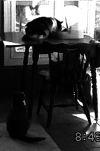Social organization in the cat: a modern understanding
- PMID: 15123163
- PMCID: PMC10822437
- DOI: 10.1016/j.jfms.2003.09.013
Social organization in the cat: a modern understanding
Abstract
An increasing body of research work has made it clear that, while Felis catus can survive in the solitary state, social groups with an internal structure, are formed whenever there are sufficient food resources to support them. Most people who have cats have two or more cats. Failure to understand what will promote either friendly or aggressive behavior can lead to various behavior problems, including aggression and conflict over resources, such as food, resting sites and litterboxes. An understanding of the natural social organization, relationships and communication between cats is therefore essential, and is the subject of this paper.
Figures










References
-
- Baerends-Van Roon J.M., Baerends G.P., 1979. The morphogenesis of the behaviour of the domestic cat: With special emphasis on the development of prey-catching. Verhaelingen der Koninklijke Nederlandse Akademie van WetenschappenAfd. Natuurkunde, Tweede Reeks, Deel, 72.
-
- Barry K.J., Crowell-Davis S.L. Gender differences in the social behavior of the neutered indoor—only domestic cat, Applied Animal Behaviour Science, 64, 1999, 193–211.
-
- Bernstein I.S. Dominance: The baby and the bathwater, The Behavioral and Brain Sciences, 4, 1981, 419–457.
-
- Bradshaw J., Cameron-Beaumont C. The signalling repertoire of the domestic cat and its undomesticated relatives. Turner D.C., Bateson P. The Biology of the Domestic Cat, 2000, Cambridge University Press: Cambridge, 67–94.
-
- Cameron-Beaumont C.L., 1997. Visual and tactile communication in the domestic cat (Felis silvestris catus) andundomesticated small felids. PhD thesis, University of Southampton.
Publication types
MeSH terms
LinkOut - more resources
Full Text Sources
Miscellaneous

